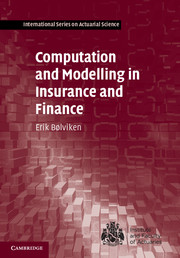Book contents
- Frontmatter
- Contents
- Preface
- 1 Introduction
- PART I TOOLS FOR RISK ANALYSIS
- PART II GENERAL INSURANCE
- 8 Modelling claim frequency
- 9 Modelling claim size
- 10 Solvency and pricing
- 11 Liabilities over long terms
- PART III LIFE INSURANCE AND FINANCIAL RISK
- Appendix A Random variables: Principal tools
- Appendix B Linear algebra and stochastic vectors
- Appendix C Numerical algorithms: A third tool
- References
- Index
8 - Modelling claim frequency
from PART II - GENERAL INSURANCE
Published online by Cambridge University Press: 05 May 2014
- Frontmatter
- Contents
- Preface
- 1 Introduction
- PART I TOOLS FOR RISK ANALYSIS
- PART II GENERAL INSURANCE
- 8 Modelling claim frequency
- 9 Modelling claim size
- 10 Solvency and pricing
- 11 Liabilities over long terms
- PART III LIFE INSURANCE AND FINANCIAL RISK
- Appendix A Random variables: Principal tools
- Appendix B Linear algebra and stochastic vectors
- Appendix C Numerical algorithms: A third tool
- References
- Index
Summary
Introduction
Actuarial modelling in general insurance is usually broken down on claim size (next chapter) and claim frequency (treated here). Section 3.2 introduced the Poisson distribution as a model for claim numbers. The parameter was λ = μT (for single policies) and λ = JμT (for portfolios) where J was the number of policies, μ the claim intensity and T the time of exposure. Most models for claim numbers are related to the Poisson distribution in some way, and this line has strong theoretical support through the Poisson point process in Section 8.2.
The intensity μ is a vehicle for model extensions. One viewpoint with a long tradition in actuarial science is to regard it as random, either drawn independently for each customer or once as a common parameter for all. Models of that kind were initiated in Section 6.3, and there will be more below. Then there are situations where variations in μ are linked to explanatory factors, such as young drivers being more risky than older ones or earthquakes or hurricanes be more common in certain parts of the world than in others. Risk may also be growing systematically over time or be influenced by the season of the year, as in Figure 8.2 later. Explanatory variables are best treated through Poisson regression, introduced in Section 8.4.
The world of Poisson
Introduction
The world of Poisson is the world of the accidental where incidents, though rare, do occur and independently of each other. Insurance processes are much like that, which suggests they can be lifted into a Poisson framework.
- Type
- Chapter
- Information
- Computation and Modelling in Insurance and Finance , pp. 279 - 313Publisher: Cambridge University PressPrint publication year: 2014

